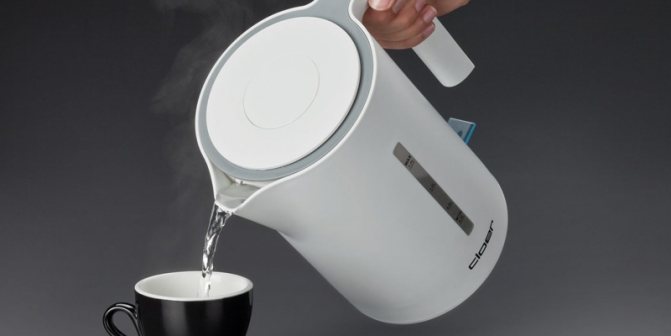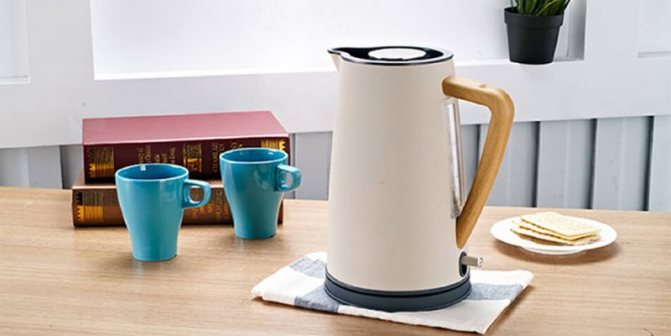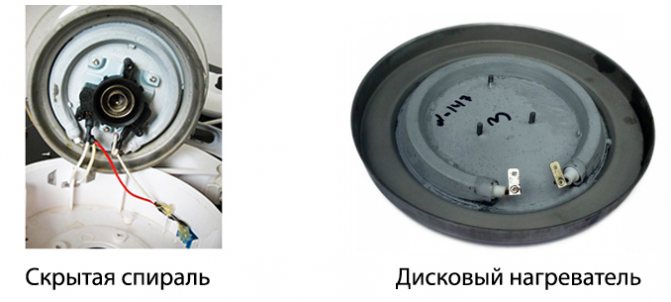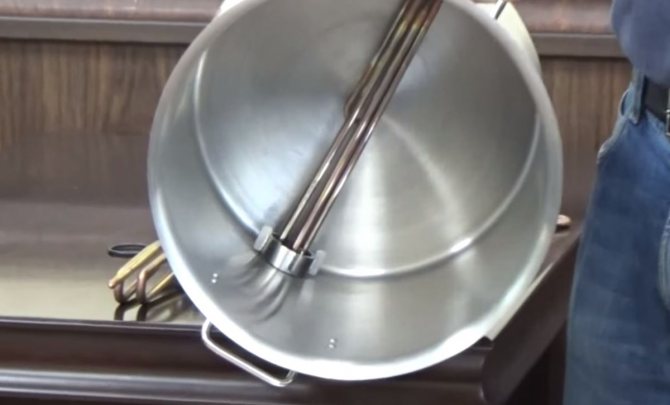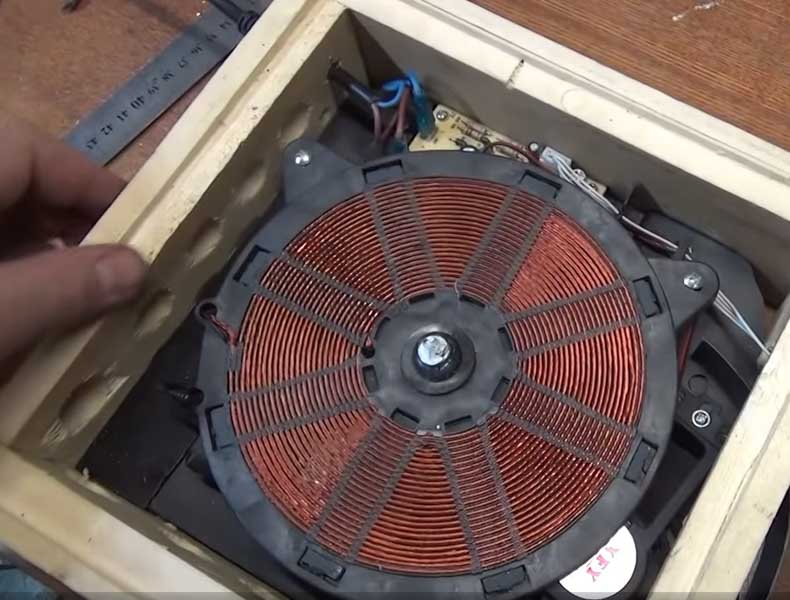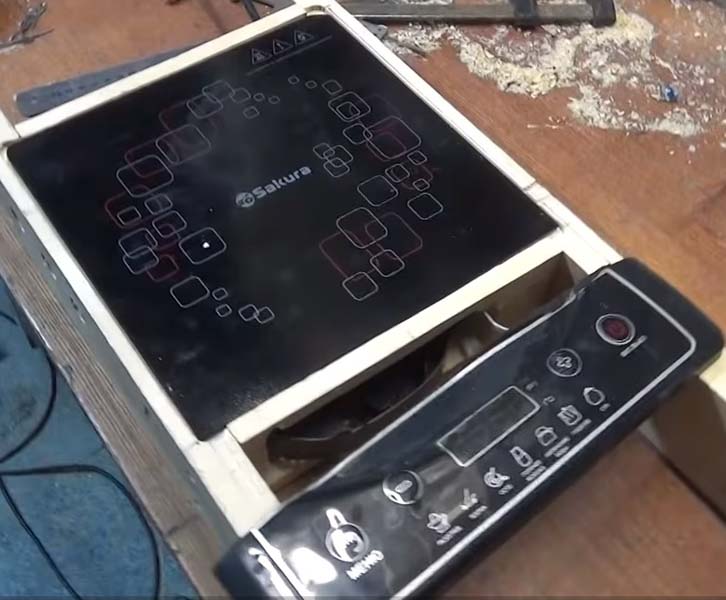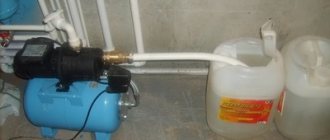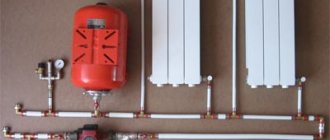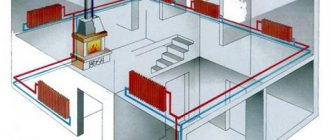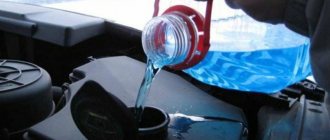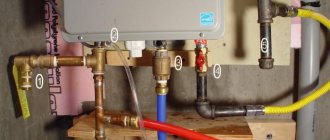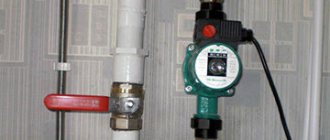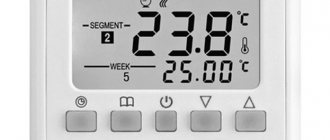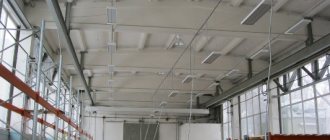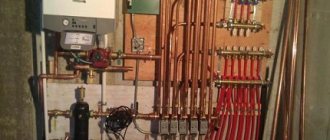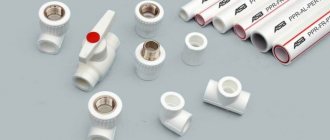Household instantaneous water heaters are compact with a power of up to 15 kW. Before installation, permits are obtained, exceeding the load limit on the power grid leads to the operation of the protection, the apartment building will be de-energized.
The high power consumption of instantaneous water heaters is associated with the need to heat a large amount of water. 2 kW is enough for washing hands or dishes. 3.5 kW will delight you with lukewarm water for a shower. Standard Khrushchev's wiring is limited to 5 kW.
Let's consider some aspects of self-repair of instantaneous water heaters.
DIY water heater: choose the type of device
Despite the fact that it is much easier to make a storage device at home, you should, first of all, consider the option of assembling a flow-through water heater. Such household appliances will allow you to instantly heat water, and electricity will be consumed only at the moment the device is turned on. Unlike boilers, installing a flow-through device does not require a lot of space, and it is also not necessary to insulate the device.
To heat water in both versions, a heating element is used, but for the manufacture of a flow-through device, it will be necessary to purchase a more powerful element.
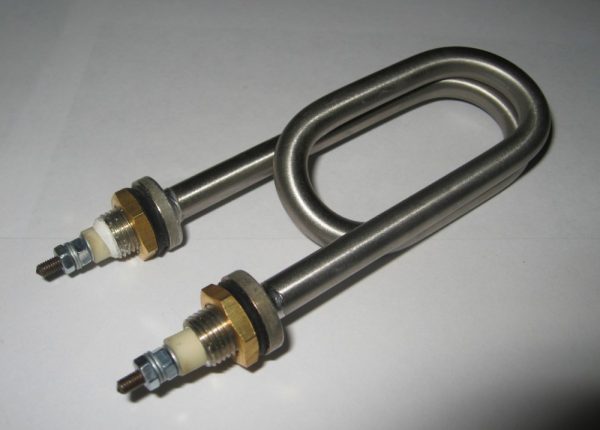
Powerful water heater
Of the additional details, you cannot do without the use of an RCD. This device will automatically disconnect the contacts if an electric leak occurs. You should also stock up on copper wires of large cross-section and tools for work.
Use in various rooms
| Room | Suitable heaters |
| Living room | Almost any type of heater is suitable for a living room. Depending on the area of the room, the best option would be a compact fan heater or convector. Models with wall or ceiling mount look stylish. |
| Bedroom | It is convenient to use mobile devices in the bedroom. Since this is a resting place, the heater should be as quiet as possible and without backlighting. The best option would be a convector with an electronic thermostat. |
| Kitchen | For a small kitchen, a desktop fan heater will be enough, it does not take up much space, if necessary, simply move it to another room or remove it. |
| Children | In the children's room, it is important to use heaters that do not heat up the body of the device very much. It is absolutely not necessary to install the oil and infrared type. |
| Bathroom | In the bathroom, models are used that are resistant to humidity. Ceiling infrared heater is suitable for use. |
Diy flow-through water heater
For the manufacture of an instantaneous water heater, the necessary tools should be prepared:
- Welding machine (inverter).
- Electrodes.
- Grinder with rust removal attachment.
- A hammer.
- Drill with a set of drills for metal.
- Kern.
For a flow-through version of a water heater, you will need the following materials:
- Steel pipe, the length and diameter of which slightly exceed the width and length of the heating element.
- Heating element electric water with a power of 4 kW.
- Sheet steel 3 mm thick.
- Anti-corrosion paint.
- Bolt and nut M14.
When everything you need is ready, you can start making the device. The first thing to do is to properly clean metal surfaces from rust. To do this, you must use a grinder with a nozzle.
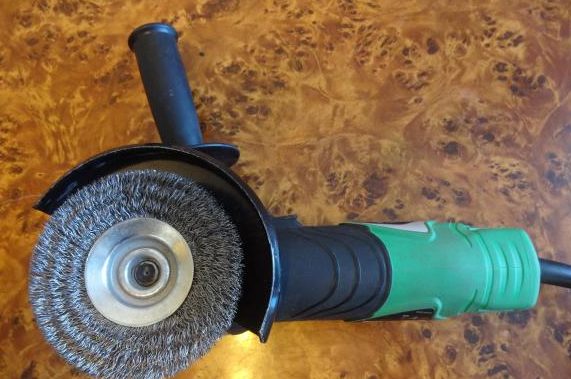

Grinder with rust removal attachment
Then a rectangle is cut from the metal sheet, the minimum side of which should slightly exceed the outer diameter of the metal pipe.On the cut metal sheet, 2 holes are made with a drill, the diameter of which should be 1 mm larger than the thickness of the heating element legs. To position the holes at the required distance from each other, the ends of the contact rods should be lowered into white paint and then lean the ends of the contacts against the plate, trying to make marks equidistant from the side faces of the plate. When the paint dries a little, it is necessary to drill the metal along the white dots.
In the next step, the plate prepared in this way should be welded to the end of the pipe. Before carrying out this operation, the part must be lightly tacked so that the previously made holes are exactly in the middle. After the side plug is welded, the metal protruding beyond the outer diameter of the pipe is cut off with a grinder or a gas cutter.
Further, having marked with a core at a distance of 20 mm 2 points, which must be on the same line, make holes with a diameter of 19 mm with a drill. These holes are necessary for welding the threaded pipe sections for connecting the water supply and removing the heated liquid.
Considering the need for grounding, it is imperative to weld an extended M14 nut to the pipe, to which the conductor will be connected with a bolt.
In the next step, the electrical heating element should be placed inside the pipe. The legs of the device should be carefully installed into the previously made holes, and then tighten the fastening nuts with sufficient force. When installing the heating element, be sure to put rubber washers on the threaded part of the legs.
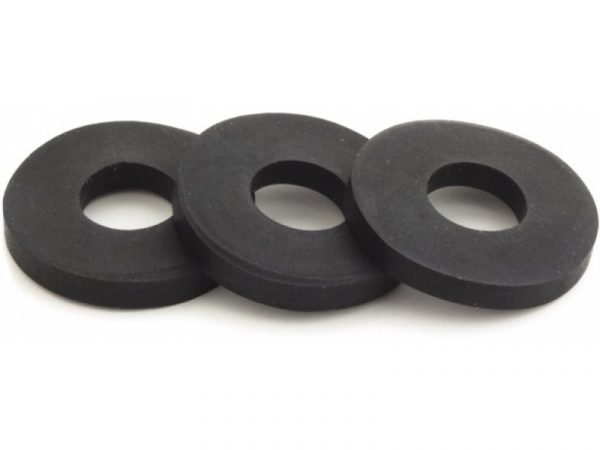

Sealing washers for heating elements
Washers should be installed on the inside and outside of the device, and for greater reliability, high-temperature sealant should be applied to the surface of the gaskets.
Then the opposite end of the metal pipe should be welded tightly. For this purpose, you should also cut a square piece of sheet steel. The side of the square must be at least 50 mm larger than the outer diameter of the pipe. To securely connect the device to the plate, it must be laid on a flat surface, then install the device turned upside down with heating elements exactly in the middle of the square so that the device pipes are located strictly perpendicular to any of the edges of the lower square and carefully weld the metal, trying not to overheat the homemade water heater too much.
When the device has completely cooled down, it is also installed upside down on a wooden board and 4 holes are made with a 10 mm drill at the corners of the bottom plate. Holes are required to mount the DIY device to the wall.
Before installing an instantaneous water heater, its functionality must be checked. For this purpose, connect the electric cable to the threaded contact of the heating element, fill the device with sufficient water to fill the entire space, and connect the device to the network.
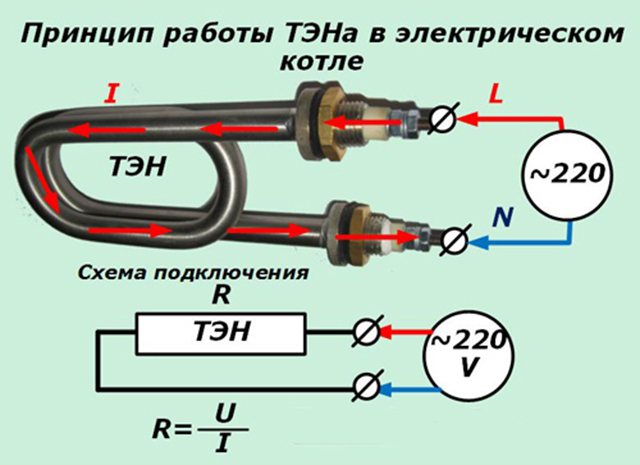

Heating element connection diagram
As soon as the water in the device boils, it should be disconnected from the power. If there are no leaks, then the homemade heater should be painted in any color with high-temperature metal paint. Before carrying out this operation, pour water out of it, degrease the surface with a solvent, and paint the device with a spray gun.
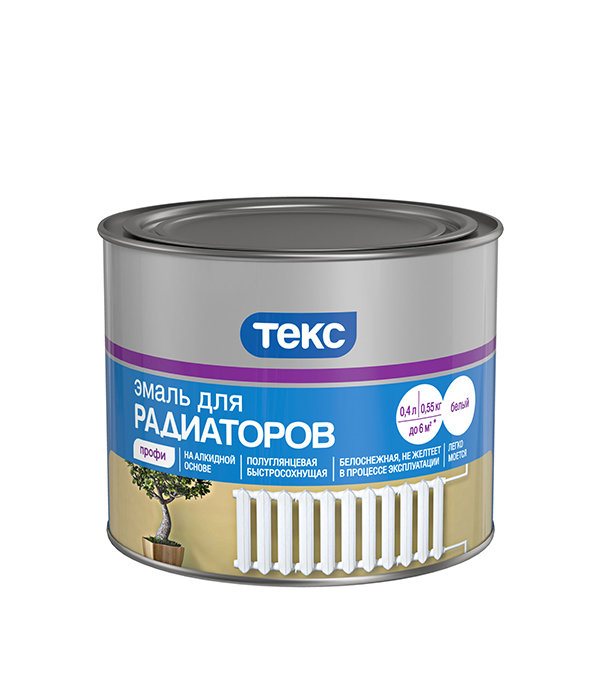

Radiator paint
When the paint is dry, you can start installing the device in the plumbing system. To do this, install the device at an equal distance from the liquid sampling points, and by placing the device with the branch pipes upwards, attach it to the wall. For this purpose, you must first make 4 holes in the vertical surface. With the help of anchor bolts, a homemade electric water heater is attached to the wall from the side of the plate in which special holes were made for this.
After the device is securely fixed, a flexible hose with cold water is supplied from the water supply network to one of the nozzles, and the other is connected to the hot water circuit.
Features of the installation and operation of the heat exchanger
Installed between the firebox and the convector:
- built into the oven;
- mounted on the chimney;
- or built into it.
The capacity of the device with a capacity of 5 liters is enough to quickly fill a 120-liter tank with hot water. It is simple to use - it is enough to organize the timely supply of liquid (continuity can be ensured by using a circulation pump) and "feed" the firebox with wood.
When installing a heat exchanger (recuperator) for a bath, the following points must be taken into account:
- the total length of pipes for water supply should be within 3 m, which minimizes heat loss;
- if the diameter of the connecting pipes is 1 inch, it is allowed not to use the circulation pump.
The longer the heat exchanger is used, the more economically viable the installation is.
How to make a thermostat for a water heater yourself
If the budget is very limited in the manufacture of a water heater, then you can make a thermostat for a water heater with your own hands. The thermal interrupter is installed as follows:
- Remove from the faulty car of any brand the thermal relay that controls the activation of forced engine cooling.
- Set the thread type of this part.
- Select a metal tube of a suitable diameter and tap the internal thread.
- Make a hole in the instantaneous water heater and weld the threaded pipe.
- Screw in the thermostat after applying a high-temperature sealant to the threads.
For the correct functioning of the heating element switching system, one cannot do without using an additional 12 V source and an intermediate relay. The relay installed in the system must be reverse acting, that is, open the circuit when a low-voltage voltage is applied to the coil. This feature is due to the fact that in the car, the radiator airflow is turned on when a certain temperature value is exceeded, while the flow-through radiator must be turned off when the temperature value exceeds the critical value.
Difference by species
The simplest designs of heat exchangers are coils with ends removed from the tank: one takes in liquid at room temperature, the other releases it already hot.
More complex ones are a system consisting of two metal tanks with anti-corrosion properties - cylindrical and rectangular with connecting pipes.
By the location of the water tank
There are two ways:
- This photo shows the option of installing a heat exchanger in a steam room, and a tank in a washing room.
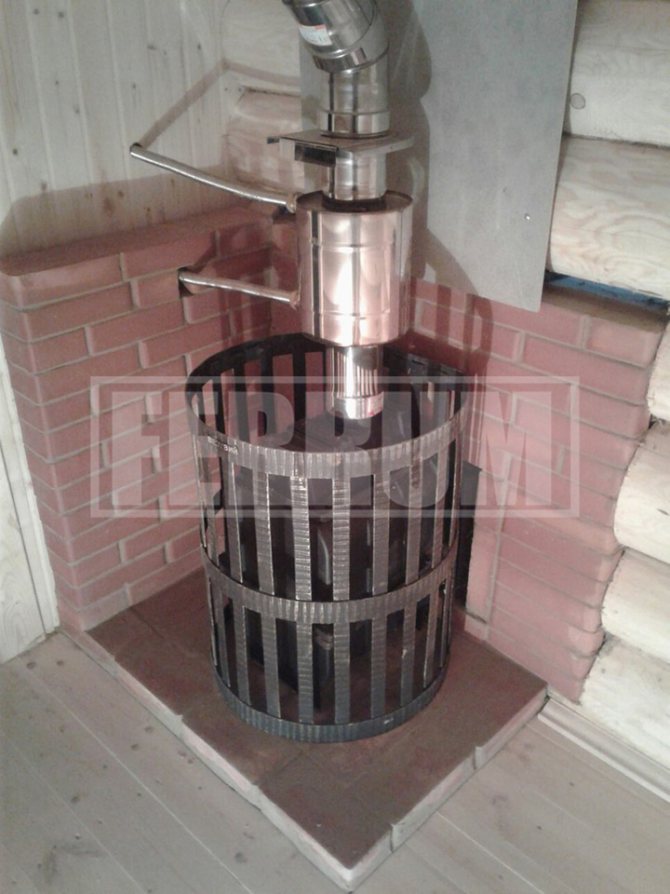

- The second option is to install a heat exchanger with a tank inside the steam room.
- high speed of water heating;
- saving free space in the steam room;
- the breadth of options for installing the tank - in a steam room or in a shower.
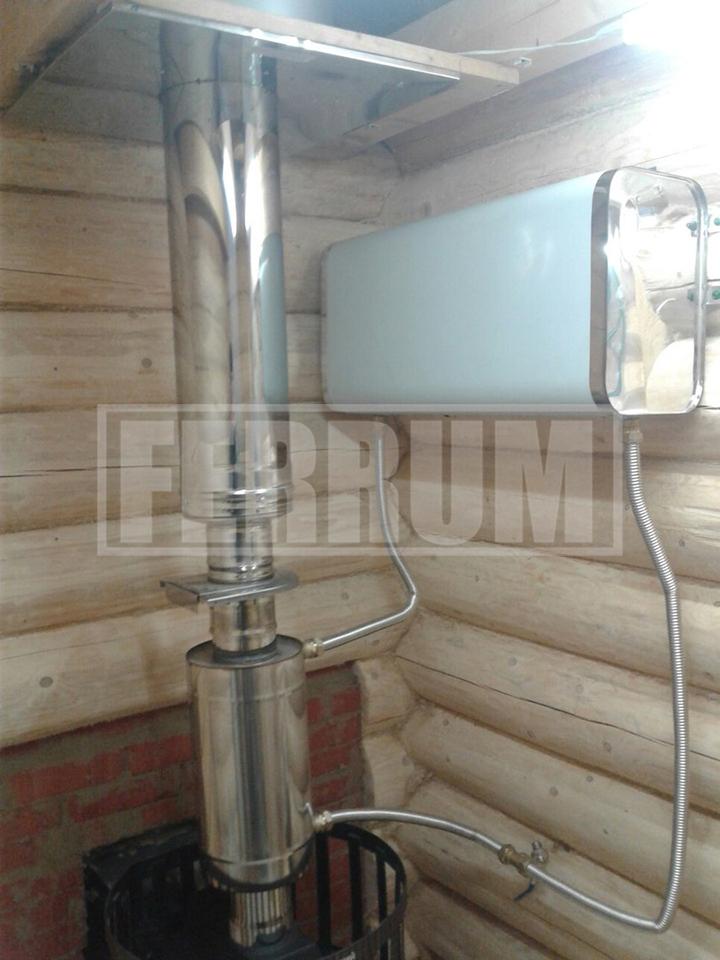

Advantages of installing a heat exchanger in a steam room
What can be done from the old heater "Ariston"
"Happy" owners of Ariston water heaters, after multiple replacement of the heating element, decide to purchase and install a device of another brand. From the old device, an excellent version of a country shower is obtained, the water for which is heated by solar energy. To convert the device into a hot water tank, you must:
- Use a grinder to cut the outer casing of the device and remove it.
- Remove thermal insulation from the inner tank.
- Degrease the surface.
- Paint the tank in matt black with any metal paint.
- Install and connect the tank to the summer shower system.
The installation of the tank should be carried out at a height of at least 2.5 meters in an area open to sunlight.The most correct would be to install a hot water device directly on the roof of the summer shower. The container should be installed in an upright position, and the water connection must be made to the drain pipe of the device, because, unlike the electric model, the water in the summer shower will be drained by gravity.
This version of a country shower is the simplest; if you wish, you can make a more complex design of a device that heats a liquid using solar energy.
How the system works
Sauna stoves with a heat exchanger must be filled with a liquid, in our case water, but if you want to use a stove for a bath with a heat exchanger for heating the premises from time to time - antifreeze.
The scheme of work is quite primitive - heating is carried out:
- thanks to natural circulation;
- using an electric pump.
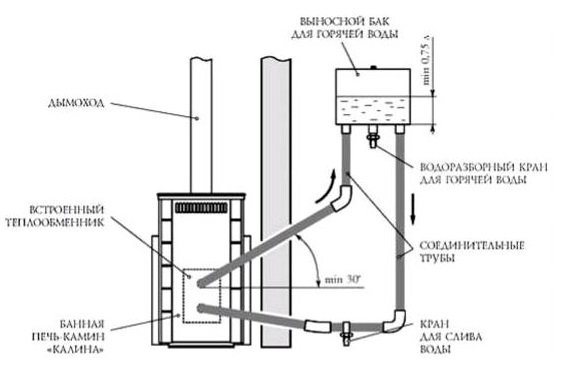

The nuances that can be encountered and that affect the efficiency of the device will be described below:
- Experts advise installing the stove in a bath with a heat exchanger with an open water heating system, i.e. no pressure;
- The most effective heating option is considered to be a system where the length of the pipes does not exceed three meters. This is enough to place the tank right behind the wall of the steam room;
- The inner diameter of the pipe for the heat exchanger must be at least 1 ″, then the liquid can easily cope with the resistance and you can not install the circulation pump.
Country version of the water heater
Homemade solar water heaters can be made in the country. The only drawback of such devices is the lack of heating during cloudy weather. The solar water heater is made of the following materials and parts:
- An old refrigerator.
- Water tank.
- Reinforced-plastic pipes with a diameter of 16 mm.
- Edged boards 200 mm wide.
- Sheet of cellular polycarbonate.
- Steel sheet with a thickness of 3 mm.
- Black metal paints.
You will also need to purchase consumables for fastening materials and various adapters for connecting pipes. In addition, you will need to buy a low-power circulation pump.
Making a solar water heater can be done in the following sequence:
- The rear radiator is removed from the refrigerator and the copper tube is cut off where the unit connects to the compressor and freezer. When performing this operation, it is necessary to preserve the original fastening elements of the part.
- A rectangle is cut out of a metal sheet with a grinder, the length and width of which should be 20 cm more than the parameters of the refrigerator radiator.
- One of the sides of the metal rectangle is cleaned, degreased and painted black. It is also necessary to paint the radiator of the refrigerator.
- When the paint is dry, place a copper grid on the painted surface of the sheet metal so that it is equidistant from its corners.
- On the painted surface of a metal sheet, with any sharp object, notches are made under the mounting holes of the copper radiator.
- Then, along the marked points, it is necessary to drill holes, the diameter of which should correspond to the holes for fastening the radiator.
- It is also necessary to make holes with a diameter of 5 mm around the perimeter of the metal sheet for attaching the side faces of the device. The distance between the holes should be about 100 mm.
- With a gas soldering iron, adapters for connecting metal-plastic pipes are soldered to the cut ends of the copper pipes.
- From the board 200 mm must be sawed off with a hacksaw. 2 segments should be equal to the width of the metal sheet, and the other two should be 50 mm less than its length. After that, the wood must be treated with a protective compound.
- Sections of the board are installed on an edge along the perimeter of a metal sheet and screwed with self-tapping screws on wood through previously made holes.
- A copper radiator is installed inside the "box", which is bolted to the metal plate. Branch pipes with adapters for connecting a metal-plastic pipe should be brought out through the holes made with a feather drill in one of the side boards.
- Cut a rectangle from a sheet of transparent cellular polycarbonate, which will be equal to the size of the metal base.
- Screw the polycarbonate rectangle to the ends of the boards with self-tapping screws with rubber washers.
- The freezer compartment must be installed in the water tank, removed from the refrigerator, to the copper pipes of which the adapters must also be soldered. The freezer should be fixed in the lower part of the tank, and the branch pipes should be led out to one of the side walls.
The simplest heat exchangers
To facilitate the selection of the unit, we suggest that you familiarize yourself with the following options.
Coil for ovens
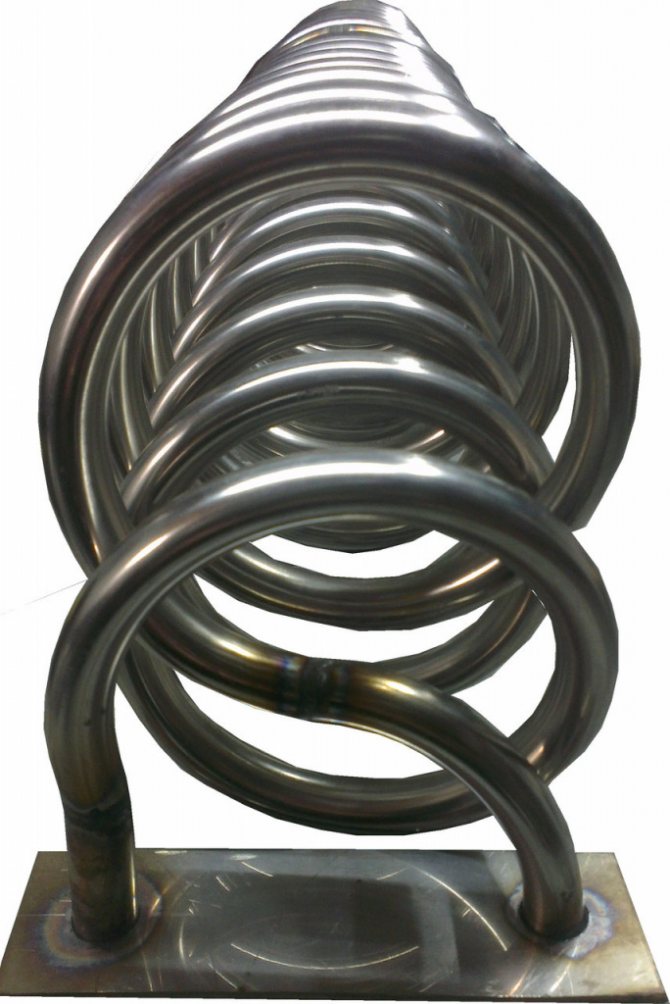

The simplest variant of a heat exchanger is a pipe (made of aluminum, copper or other ductile and anticorrosive metal), bent into a spiral or, less often, of a different shape. The carrier efficiently moves along it by gravity if its total length is less than 3 m. It is heated by hot air, and not by contact with fire. At the ends of such a structure, a thread (external) is produced - for a fitting connection with a tank.
The coil can be located both directly in the firebox, inside and outside it. Its shape can be very different, starting from the simplest U-shaped horseshoes, continuing with the already mentioned spirals with a different number of turns and ending with complex welded registers. The latter are made for the sake of increasing reliability and reducing energy losses, but since they are large-sized, they are usually placed in spacious heaters.
Rectangular tank on a pipe
This is another type - no longer an internal cylindrical container, but a structure consisting of an airtight stainless steel case.
The principle of operation remains the same - the heated liquid rises into the tank, the cooled one goes back. In implementation, a chimney with a diameter of Ф115mm (without the use of an adapter) or 110mm (with use) is suitable for it, and the ingress of exhaust steam into the room is almost impossible. True, the system must be airtight, it is important to replenish the structure with water in a timely manner.
Experienced craftsmen's recommendations
Here are some more tips on how to install a heat exchanger in a bath as efficiently as possible:
- If you do not plan to use a circulation pump, make the pipeline at a slope of 50 so that the liquid is displaced by gravity.
- Do not take too large a tank and / or do not pour too much water into it, because it simply will not have time to reach a comfortable temperature in the time you need.
- Pay maximum attention to sealing - during assembly, do not hesitate to check the quality of each joint several times.
Choose durable materials and a suitable design, make the calculations correctly, strictly follow the instructions and recommendations. A competent craftsman knows how to make and connect a heat exchanger in a bath, because the correct installation will be the key to the safe operation of the equipment, and therefore comfortable bathing after the steam room.
Finally, a video on how the universal heat exchanger model is arranged:
Rating of the best heaters with an electric spiral
| Nomination | a place | Name of product | price |
| Rating of the best heaters with an electric spiral | 1 | Stadler form max | 6 990 ₽ |
| 2 | Stiebel Eltron CK 20 Trend | 9 900 ₽ | |
| 3 | Soler & Palau TL-40 | 4 864 ₽ | |
| 4 | Ballu Classic BOH / CL-07 | 1 873 ₽ | |
| 5 | Timberk TFH S10MMS | 543 ₽ | |
| 6 | RESANTA TVS-1 | 740 ₽ | |
| 7 | Ballu BFH / S-10 | 790 ₽ | |
| 8 | Scarlett SC-FH53016 | 788 ₽ | |
| 9 | SUPRA TVS-F08 | 380 ₽ |
The review is based on data from the analytical portal RankQuality.com.
Stadler form max
Rating: 4.9
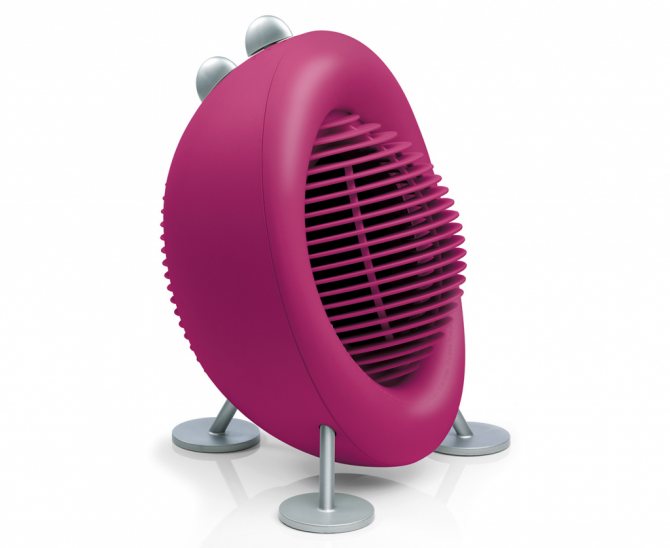

Many positive words from domestic users go to the Stadler Form Max fan heater. The development of the Swiss company captivated consumers with its unique design. The manufacturer offers several color options.Despite the high price, the experts gave the device the palm for high quality, no plastic smell, and quiet operation. The advantages of the heater include ease of control; any user can figure out the settings. With a power of 2 kW, the device will make a comfortable microclimate in a room with an area of 25 sq. m. The device can be used in summer as a fan.
Most of all Russian homeowners like the great design, quiet operation, durability of the coil heater. The only drawback is the high price.
Dignity
- exquisite design;
- quiet work;
- there is no smell of plastic;
- fan mode.
disadvantages
- high price.
Stiebel Eltron CK 20 Trend
Rating: 4.8
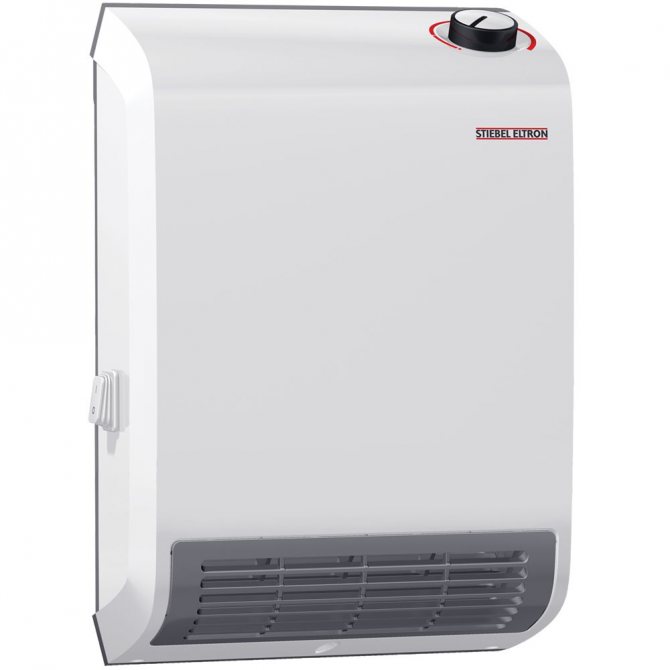

The German spiral fan heater Stiebel Eltron CK 20 Trend can be used as an additional source of heat in an apartment or house. This wall-mounted appliance is compact and highly efficient. The power of the heater is 2 kW, it is regulated within the temperature range from +5 to + 30 ° C by means of a thermostat. The accuracy of maintaining the temperature reaches 1 ° C. Experts are surprised by the silent operation of the device, moisture resistance, and unpretentiousness. The fan heater can withstand voltage drops, and it is also equipped with an anti-freeze function that is useful for summer residents. The device will automatically maintain the temperature in the room at the level of + 5… + 7 ° C.
The second position in the review is explained by the very high price, which is noted by many users. There are no complaints about the build quality.
Dignity
- compact size;
- precise temperature control;
- heats up the room quickly;
- anti-freeze function.
disadvantages
- high price.
Soler & Palau TL-40
Rating: 4.7


A rather original design was chosen by the Spanish manufacturer of the Soler & Palau TL-40 heater. The model is designed for wall mounting, it has a waterproof housing. With a maximum power of 1.8 kW, the device is able to create a warm environment in a room up to 20 square meters. m. Experts praised the manufacturer for the rich equipment, in this component he has no equal. The device has an automatic thermostat, temperature control, frost and overheating protection. In the summer heat, the device can be used as a fan. A switch with a light indicator helps to monitor the work.
The editorial board of expertology magazine put the model in third place due to the lack of feedback from Russian buyers. While the heater is not in demand.
Dignity
- waterproof case;
- automatic thermostat;
- two heating modes and one ventilation mode;
- frost protection.
disadvantages
- low popularity.
Ballu Classic BOH / CL-07
Rating: 4.6
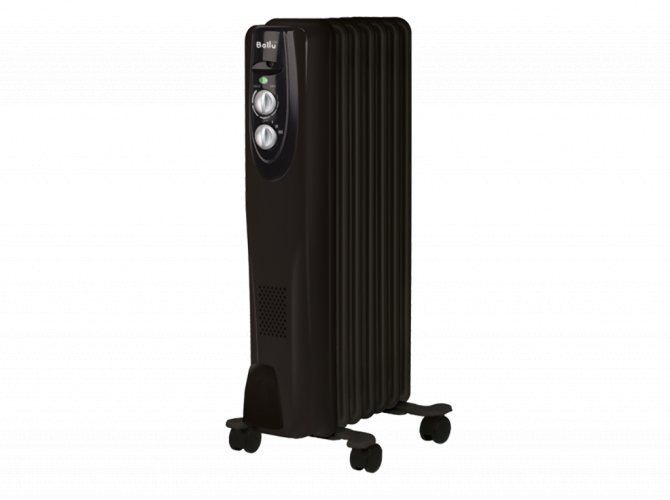

The Chinese heater Ballu Classic BOH / CL-07 has a classic design. The oil appliance has 7 sections, which give out a power of 1.5 kW. The consumer can choose one of three heating modes. The scope of the heater is premises up to 20 sq. The experts liked the automatic thermostat, thanks to which the control of the device is convenient and comfortable. For easy movement, the manufacturer has equipped the heater with castors and a handle. The model stops one step away from the pedestal, as users note a number of disadvantages.
If we analyze all the reviews, but the conclusion is that the quality is unstable. Either the thermostat does not work accurately, or defects in welds or paintwork are detected.
Dignity
- heats up the room quickly;
- stylish appearance;
- stability;
- ease of use.
disadvantages
- unstable build quality.
Timberk TFH S10MMS
Rating: 4.5
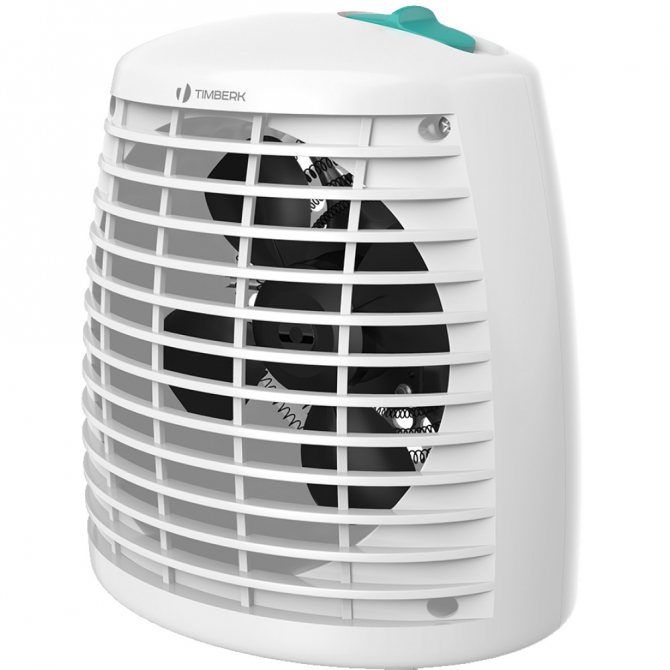

Affordability and low weight (0.7 kg) helped the Timberk TFH S10MMS spiral fan heater get into our review. The experts also praised the modern design, fast heating and compactness. The device is designed to heat small rooms (up to 12 sq. M.) Or to create a comfortable microclimate in the workplace.The device is characterized by economical power consumption (1 kW) and quiet operation. Swedish developers have taken care of the safety of the heater by equipping it with overheating protection.
Russian consumers are also satisfied with the Timberk TFH S10MMS spiral fan heater. They note such advantages of the model as lightness and compactness, ease of use and durability. Of the shortcomings, low-quality plastic stands out, which, when heated, emits an unpleasant odor.
Dignity
- lightness and compactness;
- affordable price;
- heats up the room quickly;
- durability.
disadvantages
- low power;
- the smell of plastic.
RESANTA TVS-1
Rating: 4.4
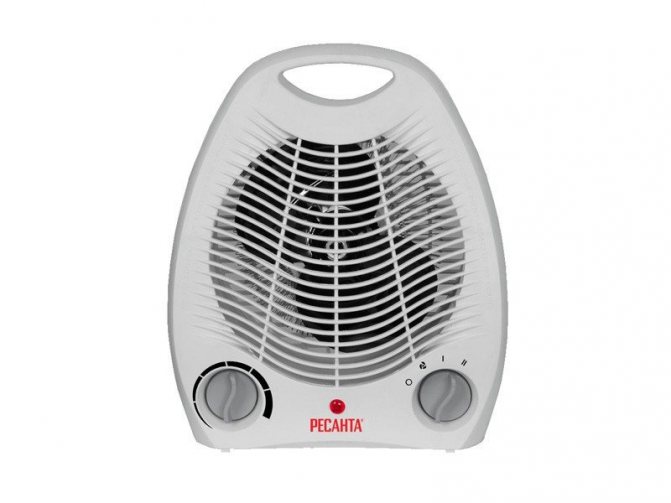

Spiral fan heater RESANTA TVS-1 can be used as a temporary heat source. This inexpensive appliance has enough power (2 kW) to create a warm environment in rooms up to 20 square meters. m. The manufacturer has installed a three-position switch, thanks to which the device can be turned on both at full power and at half power (1 kW). The device can also be used as a fan. Experts note the stylish design, quick heating, automatic temperature support. The model deservedly falls into the TOP-6 of our review.
Users love the quiet operation of the heater, its compactness and efficiency. But it is not worth turning on at full power for a long time, since the plastic begins to melt.
Dignity
- affordable price;
- lightness and compactness;
- heats up the room quickly;
- stylish design.
disadvantages
- afraid of overheating.
Ballu BFH / S-10
Rating: 4.3
The Ballu BFH / S-10 spiral heater comes into operation as quickly as possible. Experts attribute this feature of the model to a highly efficient spiral element. With a power of 2 kW, the device is capable of heating a room with an area of up to 25 square meters. m. At the same time, the Chinese device is sold at a reasonable price. The manufacturer has provided two heating modes (1 and 2 kW), as well as a ventilation function. The presence of an automatic thermostat allows you to maintain the set temperature without human intervention. In case of overheating, the device switches itself off.
Users note heating efficiency, affordable price, compact size. They attribute noise to the disadvantages of the spiral model, so it is not possible to leave the heater at night.
Dignity
- affordable price;
- automatic thermostat;
- overheat protection;
- lightness and compactness.
disadvantages
- noisy work.
Scarlett SC-FH53016
Rating: 4.2
Chinese spiral fan heater Scarlett SC-FH53016 successfully combines affordability and heating efficiency. A 2 kW device can operate in three modes: cold ventilation, warm (1 kW) and hot (2 kW) air. For ease of use, the device is equipped with a carrying handle and indicator light. Automatic overheating protection makes the use of the model absolutely safe. The experts appreciated such qualities as compactness and quiet operation. The fan heater falls into the eighth place in our review.
Domestic users liked the Scarlett SC-FH53016 spiral heater for the quick heating of rooms up to 20 sq. m., nice appearance, affordable price. Unfortunately, we come across a lot of defective products.
Dignity
- affordable price;
- three working modes;
- overheat protection;
- stylish design.
disadvantages
- a lot of marriage.
SUPRA TVS-F08
Rating: 4.1
The SUPRA TVS-F08 fan heater stands out with the lowest price against the background of competitors. A small Chinese device has a modest power (0.8 kW), which, according to the manufacturer, should be enough to heat a room up to 20 square meters. m. Experts recommend using the device in old houses with poor wiring. Household extension cords with Chinese sockets are suitable for connecting the device.The overheating protection in the device is timely triggered, turning on occurs after the case has completely cooled down. It was not possible to climb higher in our review of the model due to the rigid power cord.
Users in reviews praise the fan heater for its low price, modern appearance, fast heating. On the downside, they include a tight rotary switch and poor stability.
Dignity
- lightness and compactness;
- low price;
- economical power consumption;
- reliable protection against overheating.

